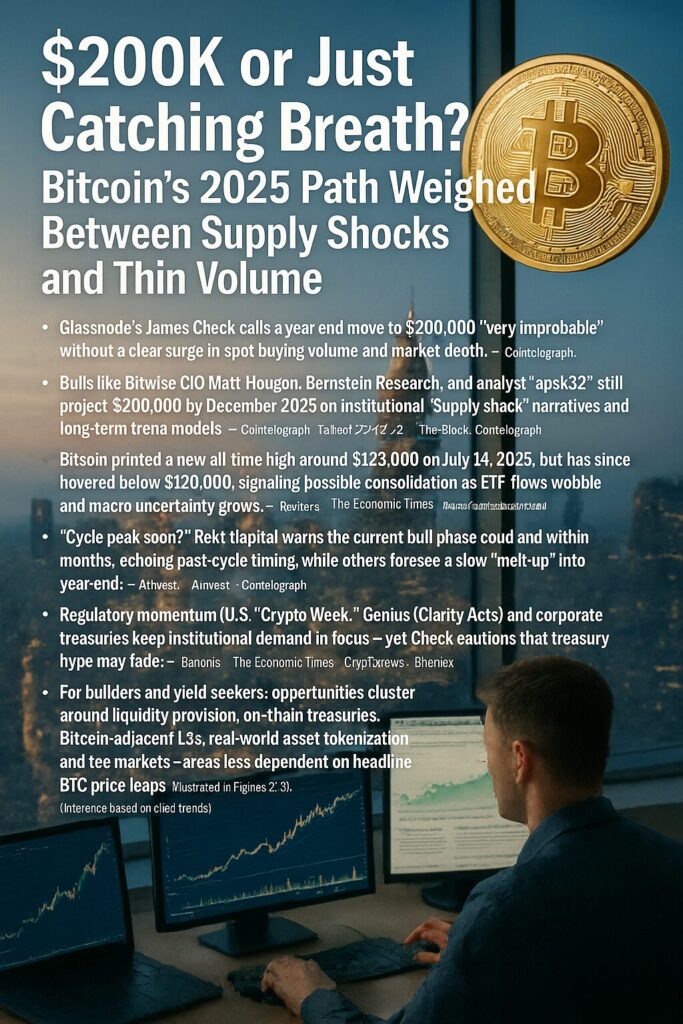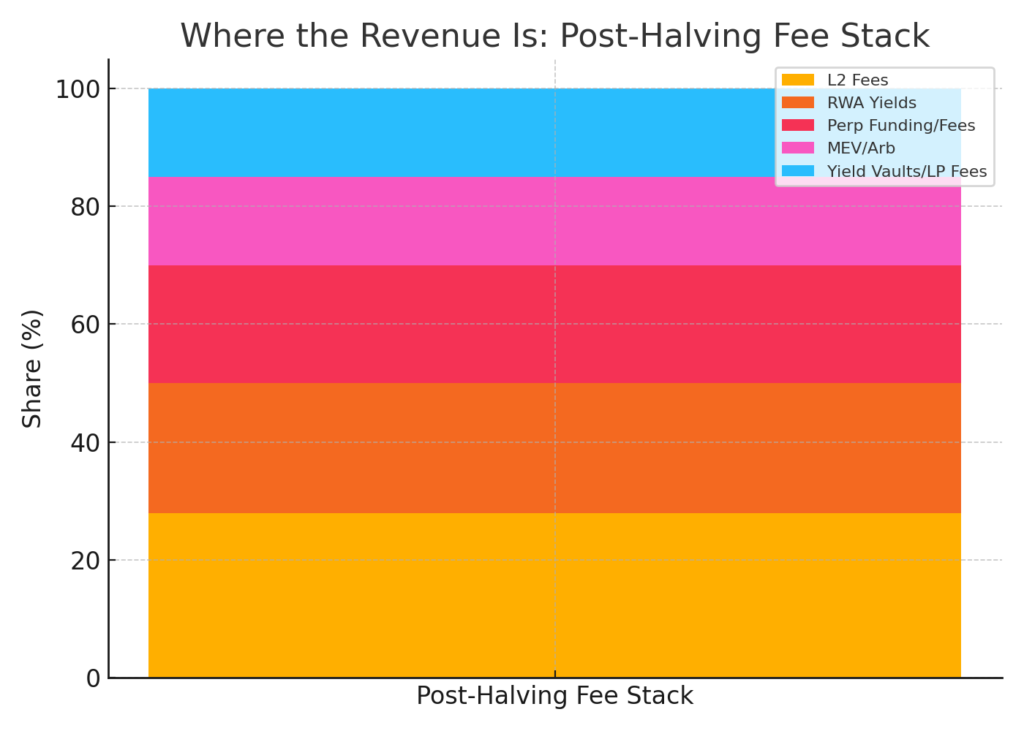
Main Points :
- Glassnode’s James Check calls a year-end move to $200,000 “very improbable” without a clear surge in spot buying volume and market depth.
- Bulls like Bitwise CIO Matt Hougan, Bernstein Research, and analyst “apsk32” still project $200,000 by December 2025 on institutional “supply shock” narratives and long‑term trend models.
- Bitcoin printed a new all‑time high around $123,000 on July 14, 2025, but has since hovered below $120,000, signaling possible consolidation as ETF flows wobble and macro uncertainty grows.
- “Cycle peak soon?” Rekt Capital warns the current bull phase could end within months, echoing past-cycle timing, while others foresee a slow “melt‑up” into year‑end.
- Regulatory momentum (U.S. “Crypto Week,” Genius/Clarity Acts) and corporate treasuries keep institutional demand in focus—yet Check cautions that treasury hype may fade.
- For builders and yield seekers: opportunities cluster around liquidity provision, on‑chain treasuries, Bitcoin‑adjacent L2s, real‑world asset tokenization, and fee markets—areas less dependent on headline BTC price leaps (illustrated in Figures 2–3). (Inference based on cited trends.)
1. Setting the Stage: Euphoria Meets Skepticism
Bitcoin (BTC) shattered the $120,000 ceiling on July 14, 2025, notching an all‑time high near $123,153 before slipping back below $120K in subsequent sessions. This price action encapsulates today’s paradox: macro tailwinds and institutional narratives versus nagging doubts about market depth.
Glassnode lead analyst James Check distilled that tension in a July 22 interview: a jump to $200,000 by year‑end would demand a near doubling of Bitcoin’s market cap, which he deems “very improbable” without convincing spot demand and volume. Check’s stance resonates with traders wary of “air pockets”—rapid ascents unbacked by structural liquidity that often reverse just as quickly.
2. The Bull Case: Supply Shock, Power Curves, and Institutional Era
Despite Check’s caution, a chorus of bulls remains. Bitwise CIO Matt Hougan reiterated that a supply squeeze from institutional adoption could vault BTC to $200,000 by December 2025, a thesis he’s pushed since at least May. Anonymous analyst “apsk32” argues that long-term power-curve modeling and two-year growth segments point to a Q4 2025 breach of $200K.
Bernstein Research has kept its $200K year-end target on the books since October 2024, calling the figure “conservative” in a 160-page “Black Book” that spotlights ETF-driven inflows and corporate treasury accumulation. This structural view: Bitcoin is in a “new institutional era,” with balance-sheet buyers and regulated products locking up circulating supply.
3. The Bear (or At Least Cautious) Case: Thin Volume, Late-Cycle Signals
Check’s critique centers on volume and realized liquidity. “Could it happen? Absolutely. Is it likely? Very improbable,” he said, stressing that without broad spot demand any push higher risks being unsustainable. Cointelegraph likewise noted earlier this month that BTC “needs fresh demand from spot buyers” to move decisively into price discovery.
Cycle analysts like Rekt Capital warn that, if 2020’s template holds, the current expansion phase might sunset within months, not years—leaving limited runway for a parabolic finale. CoinDesk’s Omkar Godbole sees gamma dynamics implying a $120K–$130K chop, while others envision a “slow melt-up” rather than liftoff. Betting markets echo the tempered odds: only ~14% price in a $200K print this year.
4. Macro & Policy Crosswinds: Rates, Regulation, and “Crypto Week”
Bitcoin’s July pop coincided with Washington’s “Crypto Week,” in which the U.S. House advanced three major bills (Genius Act for stablecoins, the Clarity Act on asset classification, and the Anti‑CBDC Surveillance State Act). Analysts argue these moves chip away at regulatory uncertainty and encourage institutional allocations.
Meanwhile, ETF flow reversals and Jerome Powell’s policy cues have injected fresh volatility: BTC briefly slipped below $117,000 amid renewed outflows, underscoring how macro tremors still reverberate through crypto.
5. Corporate Treasuries & the Sustainability Question
Corporate treasuries (MicroStrategy/Strategy, MetaPlanet, and a growing list of smaller firms) remain a narrative pillar. But James Check warns the “treasury trade” could be short-lived for latecomers, as easy branding wins fade and investors favor early adopters. If treasury flows ebb, one leg of the institutional bull stool weakens—another reason volume‑watchers stay skeptical.
6. What It Means for Builders, Yield Hunters, and Practical Blockchain Users
For your readership—hunters of new assets, revenue, and practical blockchain use—the headline BTC debate matters less than where capital migrates during consolidation phases. Three zones stand out:
- Liquidity & Basis Trades: Volatility around $120K favors market‑making on BTC and top alt perpetuals, ETF basis arbitrage, and providing liquidity to DEXs on Bitcoin L2s and EVM chains. (Inference based on ETF flow dynamics and gamma-driven ranges.
- Bitcoin Adjacent Infrastructure: Ordinals/Runes, rollups, and modular data‑availability layers tapping Bitcoin security could become fee‑generating niches no matter if BTC stalls or rips. (Inference; supported by institutional narrative of “digital gold + growth asset”.
- Tokenized Real‑World Assets (RWAs) & Yield Primitives: As stablecoin regulation clarifies, on-chain treasuries, T-bill vaults, and tokenized credit markets can scale. The Genius Act discussion signals a more compliant yield landscape—ideal for new‑asset discovery.
- Altcoin Rotation Windows: If Bitcoin consolidates, capital often trickles down the risk curve (SOL, L2 tokens, AI infra coins). Recent sessions already showed SOL strength even as BTC cooled.
7. Scenario Map for BTC into Year-End 2025
- Base Case (45%): BTC ranges $110K–$150K, grinding higher on moderate inflows; alt rotations provide outsized % moves. (Blend of Coindesk gamma view + Hougan bullishness tempered by Check’s caution.)
- Bull Case (30%): Regulatory wins + ETF inflow resurgence trigger a late Q4 melt‑up toward $180K–$200K, validating Bernstein/Bitwise calls.
- Bear/Cooldown (25%): Volume stays thin, macro risk-off hits; BTC retests $100K or below, matching betting market pessimism and Rekt Capital’s cycle-end playbook.
(Percentages are my inference based on cited sentiment and market structures.)
8. Practical To‑Dos for Investors and Builders
a. Track Real Volume & Spot Bid
Monitor on-chain realized volume, spot ETF net flows, and order book depth; let those dictate leverage.
b. Prepare for “Pause then Pop”
Accumulation strategies (DCA, cash‑secured puts) work in choppy ranges; have triggers for re‑risking if $130K+ breaks with volume.
c. Diversify Yield
Hunt compliant stablecoin yields (post‑Genius Act), BTC-collateralized lending (as JPM reportedly eyes), and cross‑chain LP fees.
d. Build Where Users Pay Fees
Whether it’s Bitcoin L2s, RWA rails, or on-chain treasuries, solve real frictions—compliance, UX, treasury ops. Berkshire-type “picks and shovels” outperform when base-layer prices stall. (Inference.)
9. Figures (Insert at Suggested Locations)
- Figure 1 “BTC Probability Bands to $200K (2025)”

- Figure 2 “Where the Revenue Is: Post‑Halving Fee Stack”

- Figure 3 “Timeline of Key 2025 Catalysts”

10. Conclusion: Between Dreams and Data
Bitcoin’s sprint to $123K and retreat to sub‑$120K territory underscores a market torn between narratives and numbers. On one side: the institutional “supply shock,” ETF funnels, and a regulatory thaw that—if sustained—could still drive BTC to the vaunted $200K mark. On the other: a glaring need for fresh spot volume, maturing cycle signals, and the ever-present macro sword of Damocles.
For investors hunting the next income stream or for builders chasing real utility, the message is clear: Don’t just bet on the headline. Build and allocate around liquidity, compliance-friendly yield, and fee-generating rails. Whether BTC coasts or catapults, those who solve real problems—treasury management, cross-chain UX, asset tokenization—will likely capture outsized returns.

